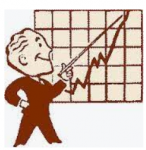The dollar rose against the major currencies last week, but the British pound, which eked out a small gain in the holiday-shortened week. The weakest was the Japanese yen, where rising US yields exerts an irresistible tug lifting the dollar to new 20-year highs. Yet, the 50-basis point hikes from the Reserve Bank of New Zealand and the Bank of Canada did not prevent their currencies from succumbing to the greenback’s surge, falling around 1.1% and 0.35%, respectively. Surging inflation was insufficient to give the ECB an added sense of urgency, and a disappointed market took the euro to its lowest level since May 2020, slightly below .0760. Dollar Index: The powerful rally extended last week, and the Dollar Index reached slightly above 100.75, its highest level
Topics:
Marc Chandler considers the following as important: 4) FX Trends, 4.) Marc to Market, Featured, newsletter, USD
This could be interesting, too:
RIA Team writes The Importance of Emergency Funds in Retirement Planning
Nachrichten Ticker - www.finanzen.ch writes Gesetzesvorschlag in Arizona: Wird Bitcoin bald zur Staatsreserve?
Nachrichten Ticker - www.finanzen.ch writes So bewegen sich Bitcoin & Co. heute
Nachrichten Ticker - www.finanzen.ch writes Aktueller Marktbericht zu Bitcoin & Co.
Dollar Index: The powerful rally extended last week, and the Dollar Index reached slightly above 100.75, its highest level in almost two years. With the small advance (~0.2%) before the weekend, the Dollar Index has risen in 11 of the past 12 sessions. The pandemic high from March 2020 was 103.00. The MACD is increasing as it has since the start of the month but remains below the peak set on March 15. The Slow Stochastic did not confirm last week’s high and has flatlined in the overextended territory. The Dollar Index has been fraying the upper Bollinger Band for the past couple of weeks. It begins the new week around 100.70. Support is seen in the 99.40-99.60 band.
Euro: Is there a bull case for the common currency, which has fallen in all but four of the year’s first 15 weeks? The interest rate differential means one is paid to be long dollars. The divergence of monetary policy suggests that the policy rate differential will widen further. The dramatic rise in energy prices, and the threat of further disruption of supplies, also contribute to its vulnerability. There are also 4.7 mln refugees from Ukraine (What a contrast to the Arab Spring reaction a decade ago). The tightness of the French presidential contest may also deter some who want to pick a bottom in the euro. The frustration with the ECB’s unwillingness to bring forward the end of its bond purchases spurred a drop in the euro that took it slightly below $1.0750 as stops were triggered when $1.08 was given. There isn’t much ahead of the March 2020 low near $1.0600. There is scope for the MACD to fall further, but the Slow Stochastic is oversold and moving sideways. A move above the $1.0925-$1.0950 area is needed to be anything of note.
Japanese Yen: The dollar has appreciated against the yen for the past 11 sessions. The US 10-year yield, uncoincidentally, has risen in nine of those sessions. As one would expect, the momentum indicators are stretched but do not seem poised to turn lower. Japanese official comments, the jawboning, have been largely limited to comments about the pace of the move, not the level. Speculative participants, trend-followers, and momentum traders have not found the official pain threshold. In the past, some US industries (e.g., autos) have complained about the yen’s weakness, but so far, nothing. Interestingly, some parts of Japanese industry have begun expressing concern about yen weakness. We had suggested a break above the JPY126.50 area would target JPY130, and more participants seem to recognize this possibility. Based on current volatility, it could be seen over the next few weeks. On the downside, initial support is likely in the JPY124.50-JPY125.00 area.
British Pound: Sterling posted a key upside reversal on April 13. Initially, the selling pressure pushed it to around $1.2975, its lowest level since November 2020. It then rallied and closed above the previous day’s high. There was follow-through the following day to almost $1.3150. before stalling. The MACD is going sideways, which is understandable. From March 15 to April 15, net-net sterling is virtually flat. Still, the Slow Stochastic has turned up. Despite intrasession violations, sterling was unable to close below $1.30. Sterling needs to re-establish a foothold above $1.32 to confirm a low is in place. Next week’s data highlights are the March retail sales and the preliminary April PMI. Both are expected to reflect the more challenging economic times. The swaps market is pricing in less than a 1-in-4 chance of a 50 bp hike at the May 5 BOE meeting (compared with 98% at the FOMC meeting the day before).
Canadian Dollar: The Canadian economy may be the fastest-growing among the major economies in Q1, with around a 4% annualized pace (Atlanta Fed’s GDP tracker says 1.1% for the US). The central bank is the first G7 central bank to hike by 50 bp. Its balance sheet will begin shrinking before the end of the month. And the Canadian dollar has fallen in seven of the past nine sessions. The drag on the Canadian dollar did not come from the two-year rate differential that saw the US small premium halved to about four basis points. Nor did the headwind come from oil prices. June WTI gained around $12.5 a barrel last week. Instead, it faces two challenges. First, the market is already discounting an aggressive tightening sequence by the Bank of Canada. The bonds bought during Covid have a shorter average maturity than other central banks. That suggests the rollover may be faster. Second, the Canadian dollar is susceptible to risk appetites, as expressed by the movement of the S&P 500. The S&P 500 fell in seven of the past eight sessions. The CAD1.2675-CAD1.2700 band may offer formidable resistance. The MACD is rising gently, but the Slow Stochastic is overextended and could turn lower early next week. Support is seen around CAD1.2525-CAD1.2550.
Australian Dollar: The Australian dollar has fallen in seven of the past eight sessions. It has fallen for three consecutive weeks, the longest decline this year. The Aussie consolidated with a lower bias for the last several sessions. It has been unable to distance itself from the $0.7400 support area that frayed a bit last week. It traded below $0.7400 on an intraday basis for a few sessions before settling below there ahead of the weekend. The next technical target is closer to $0.7350. If the rally from the January low (~$0.6970) is over, there may be scope toward $0.7300, which is also where the 200-day moving average is found. The MACD and Slow Stochastic are falling, and the latter is stretched. A note of caution comes from the lower Bollinger Band that begins the new week slightly below $0.7390.
Mexican Peso: The peso’s surge continued last week. Starting March 11, it has only fallen in four sessions. Such strong one-direction moves often seem to spark sizeable counter-trend moves. The average dollar bounce during this period has been almost 0.8%. That is what happened last week. Truckers paralyzed the Texas border, and the greenback jumped nearly 1% on April 14. It rose to around MXN20.0280, just shy of the 20-day moving average. The 20-day moving average begins the new week around MXN20.0165, and the dollar has not closed above it for a month. The MACD bottomed in early April and has been gently rising. The Slow Stochastic traded higher at the start of the month but turned down early last week. The economic highlight in the week ahead is the bi-weekly CPI figures on April 22. The headline may slow (7.5% vs. 7.6%), but the core rate may push above 7% for the first time in this cycle. Banxico is expected to lift rates another 50 bp when it meets again on May 12. We suspect the most likely scenario for the exchange rate is a consolidative phase. A move above MXN20.20 would point, instead, to a correction that could see MXN20.60.
Chinese Yuan: The US dollar is trading near the upper end of this year’s range against the Chinese yuan. The high was set on March 31 around CNY6.3860. Last week’s high, set on April 14, was slightly above CNY6.38, but it did post the highest close for the year (~CNY6.3785). The lower end of the range over the past month is about CNY6.34. Last week was the first week since early January that the greenback held above CNY6.36. The offshore yuan wobbled a bit after the small reduction in reserve requirements was announced before the weekend. The one-year medium-term lending rate was left unchanged, defying market expectations. Net-net, if anything, it was slightly firmer after the cut than before, but still in a narrow range. We suspect the Chinese currency is particularly vulnerable. The premium it offered over the US on 10-year bonds is now a small discount. The stock market is underperforming most of the other large markets. The CSI 300 (free-float index of the top 300 A-share stocks listed on the Shanghai or Shenzhen exchanges) is off a little more than 15% through the middle of April. This speaks to the loss of the portfolio channel of support for the yuan. The impact of Covid and the lockdown response will have a significant economic impact. Officials seem slow to mobilize the state’s resources (monetary and fiscal policy). At the same time, aggregate lending (the formal banking and the shadow banking) in March was 30% higher than expected (median forecast in Bloomberg’s survey). A break of CNY6.40 could signal a move to CNY6.50-CNY6.60
Tags: #USD,Featured,newsletter







